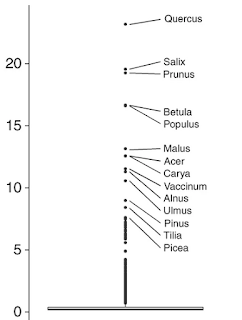I was thinning out a stand of Black Locust suckers. The stand ran approximately 60 feet in the north-south direction and half that in the east-west.
Most of the stems were in the 1-1/2" to 3-1/2" diameter range and there were way too many of them.
I followed the advice of True Blue and marked the ones I wanted to save. As suckers, they are likely to be genetically identical. I selected based on spacing and tree form and diameter, in that order. Most of the ones I saved were about 3" in diameter.
I removed about 3/4 of the stem-area or 90% of the stems. The ones that were left were unevenly scattered but none of them were closer than 6' together and most of them had a bubble of 75 square-feet.
Release cutting reduces the competition for light and moisture and these trees should take off. Release cutting also allows more light to hit the ground and can enrich the plant communities growing on the ground.
 |
| Number of butterfly species hosted by a given genus of trees in a typical, lower-48, US county. In order from the top: Oak, Willow, Plum/cherry, Birch, Poplar, Apple, Maple, Hickory/pecan, Blueberry/huckleberry, Alder, Elm, Pine, Basswood, Spruce. Source |
In a couple of cases I thinned away from some oak trees I favor and even a chokecherry. I only have three small stands of chokecherry and it is a niche-player in the ecosystem.
The brute number of plant species is not the best indicator of diversity/resilience. The author of the paper linked above suggests that trees in the genus listed are keystone species. That is, they are highly linked to more food-webs than random, throw-a-dart species.
You might notice that Black Locust is not on the list. Black Locust is also a niche player. It fixes nitrogen and makes great fence posts and pretty good firewood. It is also a good honey plant.
.jpg)
Interesting, and I learn every time you do one of these updates! Thanks!
ReplyDeleteThe attachments for your weedwacker that look like a disc with chainsaw chain wrapped around the edge are excellent for thinning suckers, multiflora roses, poison ivy etc. they cut fast and save a TON of bending over.
ReplyDeleteYessir. Mine has a 40tooth circ saw blade style attachment. Good for up to about an inch. You can take bigger, just have to work at it.
DeleteYes, locust blooms are huge for pollinators. Big push for spring. I only have 1 tree on the property that I have found.
The whole hilltop here on the homestead smells heavenly the week of Black Locust bloom . Majestic flowers with a power scent that attracts pollinators and me . Leaves and seeds are a bit poison but my Fainting Goats will only eat enough to worm themselves and maybe a little buzz in late spring . And ditto the wood is great for heating and fence posts . They don't take over in my locale like they do down south .
ReplyDeleteAre you dragging out the thinnings for use or burning/composting, or just leaving it on the ground within the area?
ReplyDeleteJerry
My plan is to trim off the whiskers and drag them back to the garden. A "farmer" never has enough gates, fence-posts or garden-poles/stakes. The trimmings will be stacked along a ridge to capture blowing snow while they decay.
DeleteI will try to take a few pictures.
I am making $92/hour telecommuting. I never imagined that it was honest to goodness yet my closest companion is earning $21 thousand a month by working on the connection, that was truly astounding for me, she prescribed me to attempt it simply. Everybody must try this job now by just
ReplyDeleteusing this website.. Www.Profit97.Com